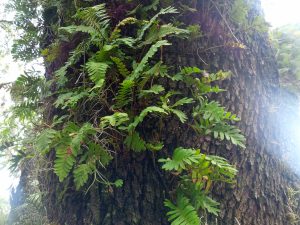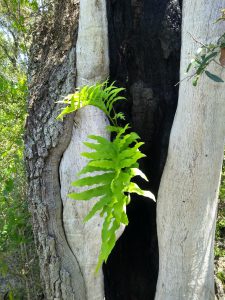What do we really lose when we lose a tree? A thousand silent voices removed from the universal chorus.
The tree is not a stand-alone unit, a single entity, a monument of stony bark, the tree is they. A connected symbiosis of lichens, fungi, epiphytes, ferns, mammals, birds, reptiles, and multitudes of insects. A mature, long-lived tree becomes even more. A tiny, bustling microcosm of activity, it is a sentinel to time, a connection to what is, was, and will be. Standing for hundreds of years, representing thousands of generations of insects, thousands of birds roosting, chattering, thousands of small mammals enveloped in safe, leafy branches. Not only the non-human; how many times has someone stopped beneath the lofty branches to dawdle in the shade, to gaze up at the patterned light and contemplate existence, children climbing, their laughter drifting on the passing clouds?

Unfurling leaf of resurrection fern, vibrant in the challenge to mortality, reminding us of the promise of life, the patient arrangement of time and opportunity. Every tree planted is a tangible expression of hope, a time capsule for a future that we will never see. So often, as we traverse the rhythms of human life, we take for granted the grasping branches breathing, cooling, and providing refuge above us. How often do we now walk with our eyes captured by the screen of a tiny computer, ignoring the miracle of evolved genius that towers over and protects us from the harsh glare of the afternoon sun?

Even in the decay of old age, past the primordial curtain of death, trees continue to provide refuge. Cavities are home to screech owls, bats, woodpeckers, whistling ducks, countless insects, and fungi. As the tree gives in to the entropy of decomposition, the nutrients feed the next generation of young trees. In old growth forests, ‘nurse logs’ provide the necessary fertility for mosses, lichens, young trees, and understory plants.
As we have developed the natural world, surrounding ourselves with straight lines and right angles, we have often shunted the decaying richness of nature to the local landfill. If you have the space and inclination, rather than remove a tree entirely, consider leaving a snag in its place. Pruned for safety and monitored, dead trees can be attractive refuges in our home landscapes. As unlikely as it seems, our landscapes interact with the landscapes nearby, forming a mosaic of potential diversity. Draped over and intertwined between our right-angled structures and hard surfaces, lies a remnant of the ecosystem that was. Leaving snags in place, when safe and appropriate, can reap fruitful rewards for diversity in our urban forests.
See these resources for more information:
Landscaping Backyards for Wildlife: https://edis.ifas.ufl.edu/publication/UW175
Dead Wood: Key to Enhancing Wildlife Diversity in Forests: https://edis.ifas.ufl.edu/publication/UW277
Managing Urban Forests for Birds: https://fufc.org/downloads/councilquarterly22v1.pdf
 2
2
